Autumnal Modulations
Listen to Autumnal Modulations
(a new version of Autumnal Modulations is featured on my Gammatar album)
This song is based on the techniques presented with my recent articles: C central note layout version 2 and Transnotating Carlos Gamma.
This song is both the first one I compose employing extensive modulations (with Carlos Gamma tuning system) and the first one completely transnotated.
Transnotation allows me to analyze my own compositions. To demonstrate that, I have recorded 2 short movies where I perform the “lead guitar” part of portions of the original tune while listening to the pre-recorded “bass” and drums parts and reading my transnotated score (see below for more explanations).
This guitar sound by Spectrasonics Omnisphere has already been featured on many songs of mine. I love it!
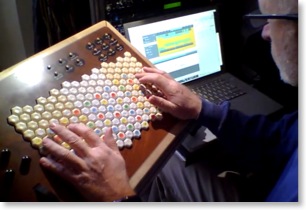
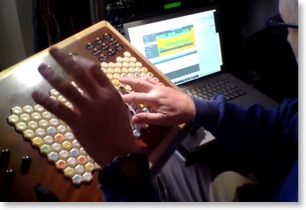
click on the pictures to watch the movies
It is probably hard to imagine the exhilarating effect that being able to analyze my Gamma songs has on me!
So far all my Gamma compositions have been created mostly following a trial and error process by ear. This method has resulted in predominantly “modal” tunes centered around a single tonal center. This newly developed note layout allows me more control of the many pitches of this tuning system and consequently more sophisticated harmonic/melodic structures.


Above you can see the diagram showing the evolution of tonal centers throughout the song. Note names refer to my own Gamma notation.
The first half of it is based on C1 (00:00 - 02:24):
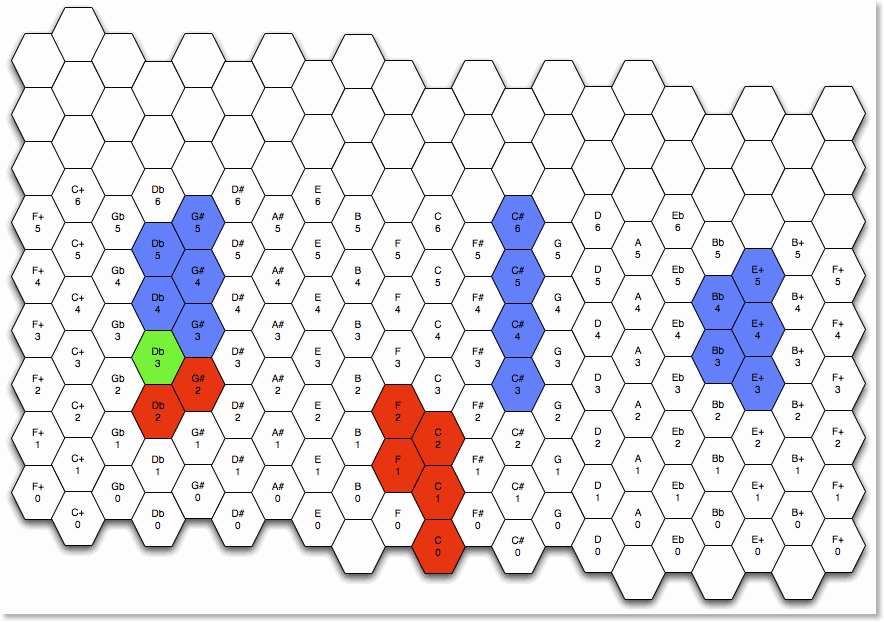

The above picture shows notes used in this section (and in the following C0 ones): red notes are played by the “bass”, blue ones by the “lead guitar” and the green one by both.
This section is very hard to perform and I really wonder how I managed to play it in the first place. Very often, when I analyze my own improvisations, I feel like someone else did it. It is a bizarre feeling as if, while improvising, I were in some altered state that let me do things I can not normally do.
It is probably hard to see the symmetry of this pattern of notes: the starting column is C, moving 3 columns to the left (B, A#, G#) you get to the G# one (as 3 columns to the left of F you find Db).
3 columns to the left of G# (Gb, F+, E+) you find E+ (as 3 columns to the left of Db you find Bb), finally 3 columns to the left of E+ (Eb, D, C#) you find C#.
Why this 4 columns pattern? See Tetrachordal Gamma
The next tonal center (from 02:24 to 03:36) is G#0:
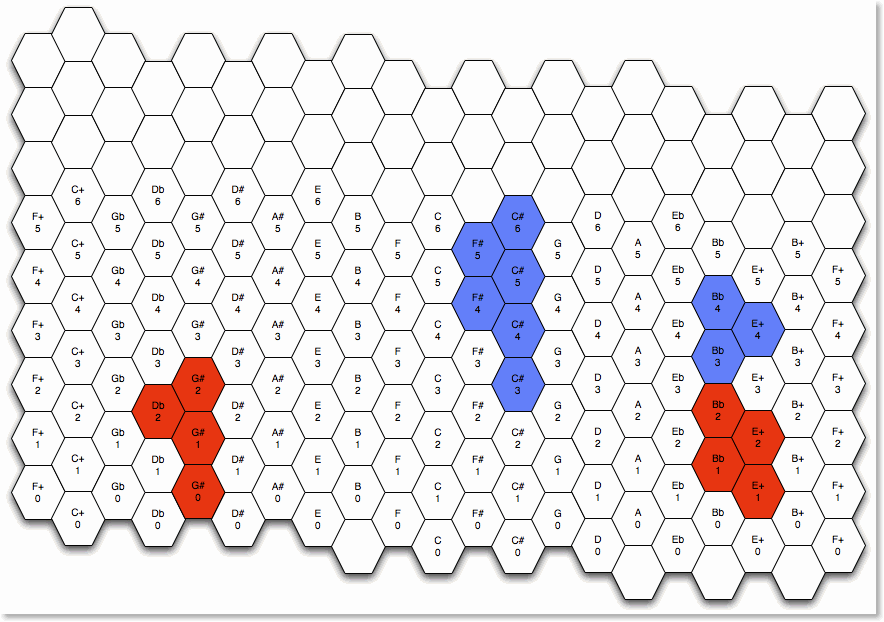

Here, again, you can see the same above mentioned procedure choosing notes for this section. It is, clearly, a simpler section than the previous one and this is the one I play on my first video starting at 02:00 of the original song (near the end of the first section) and ending at 03:36.
From 03:36 to the end of the song I modulate every 4 bars alternating between C0 (701.95 cents below C1, see above diagram) and a “compound” tonal center:

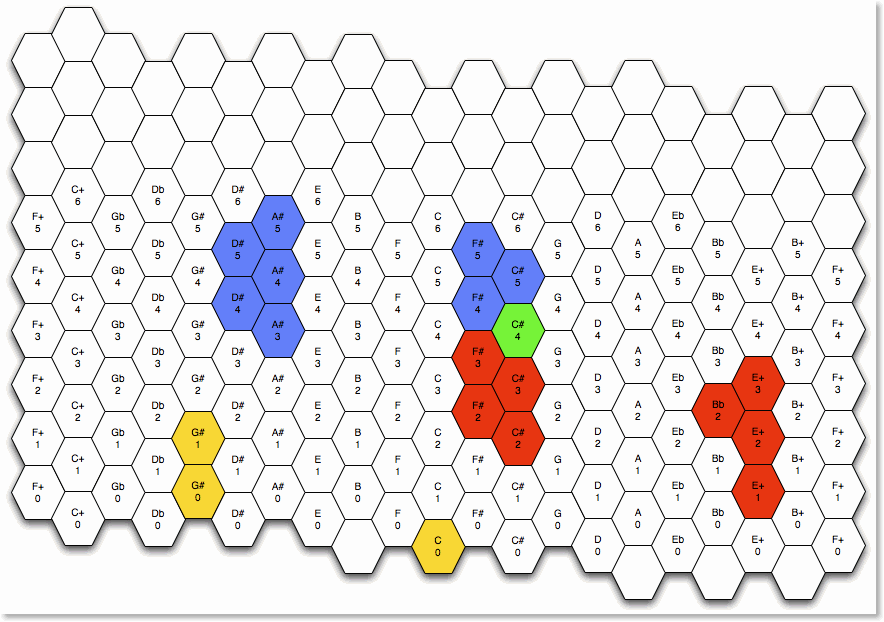
The above picture shows notes used in this section (when the tonal center is E+1/G#0): red notes are played by the “bass”, blue ones by the “lead guitar”, the green one by both and yellow ones by a “sub-bass” that I added afterwards that shifts the tonal center from E+1 to G#0 (that is why I use the symbol E+1/G#0 on the above diagram, that reminds of compound jazz chord symbols). The C0 you see here is 491.4 cents “below” the root note, so, the “sub-bass” includes the root note and 2 other notes, one a “fifth” above and one a “fourth” below it! (this means that between C0 and G#1 there is a 1193.324 cents interval, almost an “octave” ).
Once again you can see the same symmetrical procedure on the choice of notes (as explained for the first section of this song).
This section is the one I play on my second video starting at 03:36 of the original song to the end of it. Here you can see that there are phrases I can play with one hand (when the tonal center is E+1/G#0) and others that absolutely need two hands (when the tonal center is C0).
To play a song like this one live it would take two very skilled performers fluent with Carlos Gamma and isomorphic keyboards. For the time being it seems simply impossible, we will see in the future.
Links:
http://www.synthtopia.com/content/2010/10/25/microtonal-synth-jam-autumnal-modulations/
C. V. commented:
You once again raise the bar!! I hope I can find such sweet harmonies in my 22 edo guitar from Ron Sword. This is great work Carlo.
P. D. commented:
This music just brims with the forces of nature and life! Improvisation has a special unfathomable quality when it finds espression through one with feel and technique. Your experience of an altered state followed by surprise at what you bring back from 'that place' is something I've heard many diverse musicians say and write over the years.
Also, the wonderful facility to analyse improvisations to such a degree is something I've yearned for for years, because to me it's a recipe for creating even greater compositions than was possible before. Most improvised music disappears into the air, some is preserved 'as is' in recordings - now technology has created a new stepping stone for breathing the life of improvised ideas into composition.


